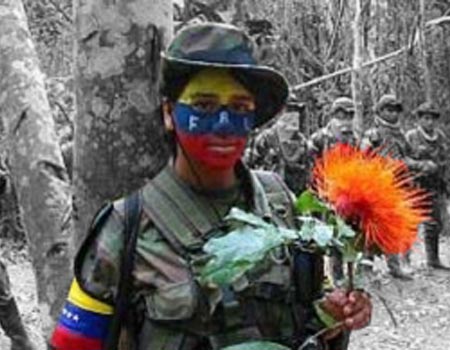The Bolivarian Liberation Forces (FBL), also known as the Patriotic Forces of National Liberation (FPLN), are a guerrilla movement in Venezuela that operates with the approval of the government and are seen as defenders of the Bolivarian Revolution.
Instead of being recognized for its military actions, the FBL has been more of a political protagonist under the guise of the Bolívar y Zamora Revolutionary Movement (Corriente Revolucionaria Bolívar y Zamora – CRBZ), which is the most visible face of this organization today.
History
The FBL emerged in 1986 as a political and military movement with Marxist and Bolivarian influences in response to the need to increase left-wing influence within Venezuela’s political sphere. However, this guerrilla organization gained greater notoriety between 1992 and 1996, when they carried out a series of attacks against corrupt officials, in what became known as “Operation Dignity.”
After a period of inactivity, the FBL reappeared after the election of Hugo Chávez as president in 1999. In 2002, the group openly expressed its support for the president, raising suspicions about collusion between the guerrillas and the government. However, both sides denied this, and Chávez himself publicly condemned the activities of the FBL as contrary to his “Bolivarian Revolution.”
Subsequently, the increase in the FBL’s participation in extortion and kidnapping between 2005 and 2008 caused internal fractures in the group. Certain leaders and members integrated a faction known as the Patriotic Forces of National Liberation (Fuerzas Patrióticas de Liberación Nacional – FPLN), which had a greater political vision and was consolidated under the support of a network of grassroots organizations in Apure, Táchira and Barinas. The names FBL and FPLN are used interchangeably today, as well as the pseudonym “Boliches.”
This political leaning led the FBL to create a political movement known as the Bolívar y Zamora Revolutionary Current (CRBZ), which has established strong networks among local activists, to the point that its main spokesperson, Héctor Orlando Zambrano, was elected to the National Constituent Assembly in 2017, and then re-elected to the National Assembly in 2020. In addition, its militants have become mayors or been elected to state governments
Although this group also has a military structure, its achievements have been more notable in the political arena. Its most prominent activities have largely focused on political activity in defense of the Bolivarian Revolution, control of local and regional political offices, and, to a lesser extent, criminal activities that finance the group.
Criminal Activity
The territorial control it exercised over several informal border crossings has allowed the FBL to extract rents from illicit economies such as smuggling and extortion. Local residents of Apure and ranchers say that in addition to extorting them, the FBL exercises authority over river crossings to smuggle cattle and gasoline from Venezuela to Colombia.
Leadership
Despite suffering internal disputes, the rebel organization’s leadership seems to remain cohesive albeit divided between political and military hierarchies.
On the political side, its most significant leaders are José María Romero, alias “Chema,” mayor of the Páez municipality in the state of Apure; Luis Tolosa, a local government official; and Héctor Orlando Zambrano, alias “Lapo,” a national assemblyman. In turn, all are active members of the CRBZ.
The true identities of the leaders of the military wing are secret. According to media sources and statements from the organization, its main leaders are Jerónimo Paz, also known as “El Flaco”; alias “Diego Rafael”; alias “Macabeo Zapata.” and alias “Reimundo Robles.” Additionally, these men allegedly are part of a General Staff that also includes men under the pseudonyms “Zacarías,” “Ernesto Guevara,” “Julián,” and “Carlos Chileno”.
Geography
Political connections and support from the peasantry have turned Apure state into the operational center of the FBL. The group has miltary units in the Páez municipality, including in the urban area of Guasdualito, where its organization is strongest, and in the parishes of Palmarito and El Nula.
There are also reports of the presence of the insurgency in Táchira and Barinas. In southern Táchira, the group has settled in the Uribante and Fernández Feo municipalities, extending to the border with Trujillo state.
Allies and Enemies
The FBL shares territory in Apure with the Colombian-born guerrillas of the National Liberation Army (Ejército de Liberación Nacional – ELN) and the dissident members of the Revolutionary Armed Forces of Colombia (Fuerzas Armadas Revolucionarias de Colombia – FARC), also known as the ex-FARC mafia.
At times, its financing activities have brought the FBL into conflict with the ELN. Although today the differences and confrontations between the two groups are negligible, the ELN continues to impose conditions in the region. This was recently demonstrated in 2022 in a show of force and territorial display that the FBL carried out in Apure amidst its conflict with the ex-FARC mafia’s 10th Front.
On the other hand, this relationship with the extinct FARC was more harmonious since he received logistical support and military training. Although there have been no disputes with the FARC dissidents, there is also no implicit alliance beyond sharing territory on the border
Prospects
Despite their lack of military power, the FBL cannot be dismissed as a political force. Through the CRBZ, the group has consolidated a wide network of grassroots organizations and local activists. This makes this guerrilla a local force that must be considered for anyone trying to do business or obtain the favor of the local population of Apure.
In that sense, the reach of their political wing could still make the FBL a useful ally for current Venezuelan President Nicolás Maduro. The CRBZ has established a significant network of peasant organizations willing to take up arms to defend the revolution if they believe it is at risk of being overthrown.

